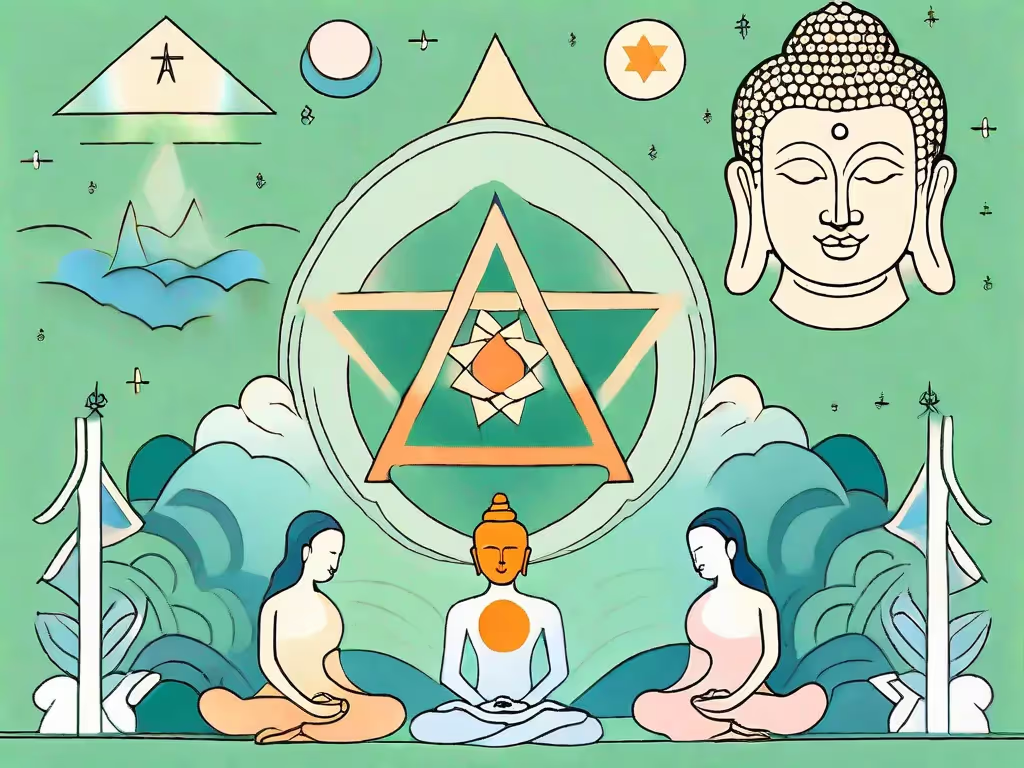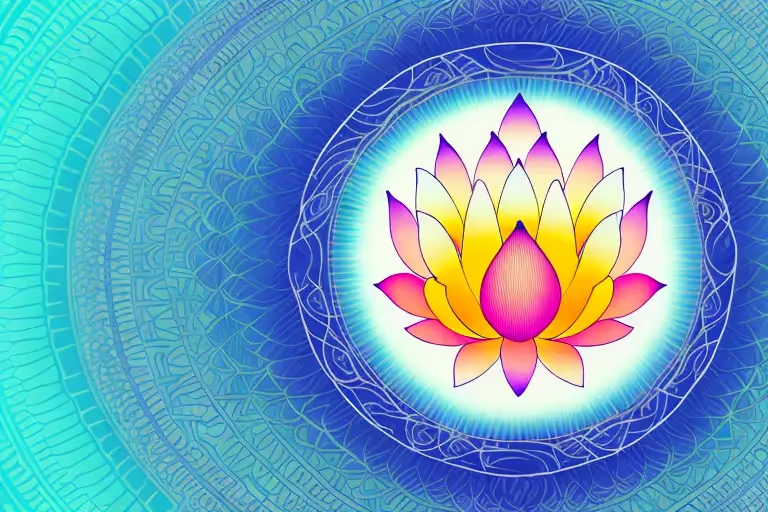Meditation has long been known to provide a range of benefits for our mental, physical, and spiritual well-being. It allows us to calm our minds, find inner peace, and connect with our inner selves. But it also offers something deeper and more mysterious: visions. In this article, we will dive into the intriguing concept of inner sight in meditation and explore the different types of visions that can be experienced. Let's embark on a journey of self-discovery and unravel the enigmatic world of meditation visions.
The Concept of Inner Sight in Meditation
When we close our eyes and enter a state of meditation, something extraordinary happens. Our minds begin to paint vivid pictures, telling stories that can be as mysterious as they are captivating. This phenomenon is known as inner sight, the ability to see visions within the depths of our own minds.
As we delve deeper into the realm of inner sight, we discover a vast landscape of imagery that is both awe-inspiring and enigmatic. It is a realm where the boundaries of reality blur, and the imagination takes flight. Each vision is unique, a kaleidoscope of colors, shapes, and symbols that hold profound meaning.
Defining Inner Sight
Inner sight, also referred to as inner vision or the mind's eye, is the faculty of perceiving images, symbols, and scenes within one's consciousness during meditation. It is the portal through which we gain insights, explore our subconscious, and tap into the wellspring of creativity that resides within us.
When we close our physical eyes, we open the eyes of the soul. Inner sight allows us to see beyond the limitations of the physical world and delve into the realm of the unseen. It is a form of perception that goes beyond the five senses, transcending the boundaries of time and space.
The Role of Inner Sight in Meditation
So, why do these visions occur during meditation? The answer lies in the way meditation affects our brain and consciousness. By entering a state of deep relaxation and heightened awareness, we create the perfect conditions for our minds to conjure up vivid images and tap into our subconscious minds. Inner sight becomes a gateway to a deeper level of self-understanding and exploration.
During meditation, our brain waves shift from the active beta state to the more relaxed alpha and theta states. In these altered states of consciousness, our minds become more receptive to the subtle energies and vibrations that surround us. It is in this receptive state that inner sight blossoms, allowing us to access the hidden realms of our psyche.
Through inner sight, we can explore the landscapes of our memories, unravel the mysteries of our dreams, and gain insights into our deepest desires and fears. It is a journey of self-discovery, a path that leads us to a greater understanding of ourselves and the world around us.
As we navigate the realms of inner sight, we may encounter archetypal symbols, ancient wisdom, and glimpses of our true potential. These visions can serve as guideposts on our spiritual journey, offering us glimpses of the divine and the interconnectedness of all things.
In conclusion, inner sight is a profound and transformative aspect of meditation. It opens the doors to a world of infinite possibilities, where the boundaries of reality dissolve, and the depths of our consciousness are revealed. Through inner sight, we embark on a journey of self-exploration and self-discovery, unlocking the hidden treasures of our minds and souls.
The Science Behind Visions in Meditation
While visions during meditation are often considered mystical, researchers have begun to explore the scientific basis behind this phenomenon. Recent data shows that meditation affects the brain in ways that can enhance our capacity for inner sight.
When we enter a meditative state, our brain waves shift from the active beta state to the more relaxed alpha and theta states. This change in brain activity allows us to access deeper levels of consciousness and tap into our intuitive abilities.
The Brain and Meditation
Neuroscience has revealed that different areas of the brain are activated during meditation, including the visual cortex. This means that as we quiet our minds and enter a meditative state, our brains become more receptive to visual experiences, leading to the emergence of visions.
Studies have shown that experienced meditators have increased gray matter density in the visual cortex, suggesting that regular meditation practice can enhance our visual processing abilities. This heightened visual perception can manifest as vivid and detailed visions during meditation.
Furthermore, research has found that meditation can increase the production of DMT (dimethyltryptamine) in the brain. DMT is a naturally occurring psychedelic compound that is known to induce vivid and profound visual experiences. This suggests that the visions experienced during meditation may be influenced by the release of DMT in the brain.
Interpreting Visions in Meditation
Visions in meditation can take various forms, such as symbolic or literal imagery. Symbolic visions can reveal profound insights and offer glimpses into our deepest desires, fears, and aspirations. These symbols often require interpretation and can serve as powerful tools for self-reflection and personal growth.
Literal visions, on the other hand, depict scenes and scenarios that may have personal significance or provide guidance for our lives. These visions can be like a window into our subconscious, offering us valuable information about ourselves and our path forward.
It is important to approach the interpretation of visions with an open and curious mind. Just as dreams can be rich in symbolism, so too can visions during meditation. Exploring the meaning behind these visions can lead to profound self-discovery and a deeper understanding of ourselves.
In conclusion, the science behind visions in meditation is still a field of ongoing research. However, the evidence suggests that meditation can activate different areas of the brain, including the visual cortex, and enhance our capacity for inner sight. The visions experienced during meditation can provide valuable insights and guidance, whether through symbolic or literal imagery. As we continue to delve into the science behind this mystical phenomenon, we may uncover even more fascinating discoveries about the power of meditation and the mind.
Different Types of Visions Experienced in Meditation
Now, let's turn our attention to the different types of visions that can be experienced during meditation. Each type offers a unique window into our inner world and provides valuable insights into our subconscious mind.
Symbolic Visions
Symbolic visions often present themselves in the form of metaphors, archetypal images, or abstract symbols. They speak the language of the unconscious and can convey deeper meaning and messages that may require interpretation. These visions can unlock hidden truths and shed light on aspects of ourselves that are shrouded in mystery.
Literal Visions
Literal visions, on the other hand, are more concrete and representational. They depict scenarios or scenes that may mirror real-life events or circumstances. These visions can provide guidance, offer solutions to challenges we may be facing, or even foreshadow future events.
The Significance of Visions in Meditation
Visions experienced during meditation hold immense significance, as they can play a transformative role in our personal growth and spiritual development.
Personal Growth and Visions
Visions act as mirrors that reflect the hidden aspects of our psyche, allowing us to gain a deeper understanding of ourselves. By exploring the symbolism and messages behind these visions, we can uncover unresolved emotions, discover our passions, and identify areas for personal growth and healing.
Spiritual Insights from Visions
Visions hold the key to spiritual insights and revelations. They invite us to explore mystical realms, connect with our higher selves, and tap into divine wisdom. Through visions, we can receive guidance, gain clarity on our life's purpose, and experience profound spiritual transformation.
Techniques to Enhance Inner Sight During Meditation
If you wish to enhance your experience of inner sight during meditation, there are specific techniques you can incorporate into your practice.
Mindfulness and Inner Sight
Mindfulness is a powerful tool that can deepen our connection with the present moment. By cultivating mindful awareness, we can sharpen our inner sight and increase our receptivity to visions. Through focused attention and non-judgmental observation, we create a fertile ground for our inner world to unfold.
Visualization Techniques
Visualization techniques can be used to actively invite visions during meditation. By intentionally visualizing images or scenes, we can harness the power of our imagination and open ourselves to receive insights and guidance. Visualization can be a potent ally in enhancing our inner sight and expanding our consciousness.
As we conclude our exploration of visions experienced in meditation, may you find inspiration and clarity through your own inner sight. Remember that the Aura Health App provides guided meditations and mindfulness exercises to help you dive deeper into your practice and unlock the profound visions that await within you.
Aura is Your All In One App for Meditation, Mindfulness Wellbeing
Find peace every day with one app for your whole well-being. There is no one-size-fits-all solution to mental well-being. Aura is the first all-in-one wellness app that learns how to best help you. Discover an endless library of expert-created tracks for your well-being, all taught by the world’s best coaches, therapists, and storytellers. With Aura's personalized recommendations, you can find peace every morning, day and night.



.webp)






.avif)

%20(1).avif)


.avif)
.avif)
.webp)


.avif)


















































































































.avif)

















.svg)









